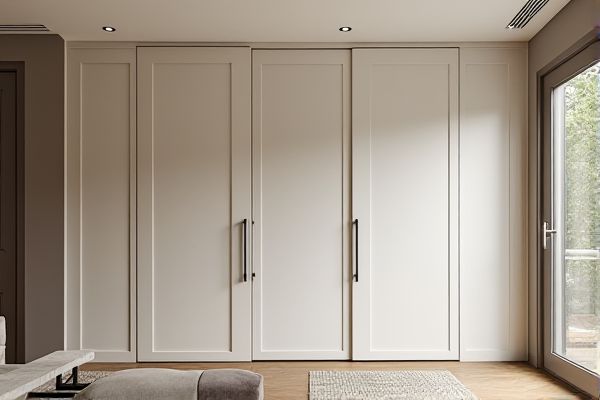
Tambour doors offer a space-saving solution by sliding open along tracks, making them ideal for tight areas, while hinged doors provide full access with a traditional swing that suits larger spaces. Explore the rest of this article to discover which cabinet door style best fits your needs and enhances your space.
Table of Comparison
| Feature | Tambour Door | Hinged Door |
|---|---|---|
| Design | Slatted door that rolls or slides into a housing | Traditional swinging door attached with hinges |
| Space Efficiency | Ideal for tight spaces; door retracts without swinging out | Requires clearance for door swing |
| Installation | Complex; requires tracks or guides | Simple; standard hinge installation |
| Durability | Slats may be prone to wear or damage | Robust and long-lasting with proper maintenance |
| Maintenance | Tracks need regular cleaning to prevent jamming | Hinges may require occasional tightening or lubrication |
| Cost | Generally higher due to complexity | Typically lower and widely available |
| Aesthetic | Modern, sleek look; blends well with contemporary designs | Classic, versatile style suited for various decors |
Overview of Tambour Doors and Hinged Doors
Tambour doors consist of narrow slats connected by flexible backing, allowing them to roll or slide open smoothly, making them ideal for compact spaces and modern cabinet designs. Hinged doors are traditional cabinet doors attached by side-mounted hinges, providing full access and a classic aesthetic, typically requiring clearance space to open outward. Both door types offer distinct functionality and space management advantages, catering to different design preferences and usage requirements.
Design and Aesthetic Differences
Tambour doors feature a sleek, segmented design that rolls or slides smoothly along tracks, creating a modern and space-saving aesthetic ideal for contemporary cabinet styles. Hinged doors offer a classic, traditional appearance with solid panels that swing outward, providing a more substantial and versatile look suited to various decor themes. The continuous, slatted surface of tambour doors contrasts with the flat, framed panels of hinged doors, influencing light reflection and visual texture in cabinetry design.
Space Efficiency Comparison
Tambour doors excel in space efficiency by sliding vertically or horizontally into the cabinet, eliminating the need for clearance space required by hinged doors that swing outward. Hinged doors demand a clear area in front of the cabinet, making them less suitable for tight or narrow spaces. Your choice should consider the available room, with tambour doors providing a compact solution ideal for maximizing limited space.
Installation Process and Complexity
Tambour doors require a more intricate installation process due to their rolling mechanism and need for precise alignment within tracks, making them more complex than hinged doors. Hinged doors involve straightforward mounting using hinges, which allows for quicker and simpler installation. Your choice will impact installation time and difficulty, with tambour doors demanding greater technical skill and patience.
Material Options for Both Door Types
Tambour doors typically use flexible materials like aluminum slats, wood strips, or PVC that roll smoothly within a track system, offering space-saving benefits ideal for tight kitchen areas. Hinged doors are available in a broader range of materials, including solid wood, MDF, glass, and laminate, allowing for more customized design and finish options that suit various interior styles. Your choice depends on the material durability and aesthetic preferences aligned with your cabinetry needs.
Durability and Maintenance Considerations
Tambour doors feature a flexible slatted design that resists warping and requires minimal maintenance, making them highly durable in environments with fluctuating humidity. Hinged doors, typically constructed from solid wood or MDF, may be more vulnerable to expansion, contraction, and mechanical stress on hinges, requiring occasional adjustments or repairs. Both options demand routine cleaning, but tambour doors tend to accumulate less dust in their sliding tracks compared to the hinges of traditional doors.
Accessibility and Ease of Use
Tambour doors offer superior accessibility in tight spaces by sliding open vertically or horizontally without requiring clearance for swing, making them ideal for compact areas. Hinged doors provide a full, unobstructed opening, allowing easier access to the entire cabinet interior but need sufficient space for the door to swing open. Ease of use depends on the environment; tambour doors require smooth tracks and maintenance to prevent jamming, while hinged doors rely on durable hinges for longevity and straightforward operation.
Cost Analysis: Tambour vs. Hinged Doors
Tambour doors typically have higher upfront costs due to their complex sliding mechanism and specialized materials, whereas hinged doors are generally more affordable and easier to manufacture. Maintenance expenses for tambour doors can also be greater because their tracks and slats require periodic cleaning and lubrication to function smoothly. Hinged doors offer lower long-term costs with simpler repairs and replacements, making them a cost-effective option for budget-conscious cabinetry projects.
Best Applications: Where Each Door Excels
Tambour doors excel in spaces requiring compact, space-saving solutions such as home offices, kitchens, and entertainment centers where sliding mechanisms prevent obstruction in tight areas. Hinged doors are ideal for traditional cabinetry with ample clearance, providing full access to the cabinet interior, making them perfect for large kitchens and storage rooms. Each door type enhances functionality based on the spatial layout and user access needs, with tambour doors favoring confined spaces and hinged doors suited for open, easily reachable areas.
Which Cabinet Door Is Right for You?
Tambour doors offer space-saving functionality with their roll-up design, ideal for tight or narrow kitchen areas where traditional hinged doors might obstruct movement. Hinged cabinet doors provide full access to the cabinet interior, making them suitable for larger kitchens with ample clearance and those prioritizing classic aesthetics. Consider your kitchen layout, ease of access needs, and style preferences to determine whether the compact, modern tambour door or the traditional hinged door best fits your cabinetry requirements.
 homyna.com
homyna.com